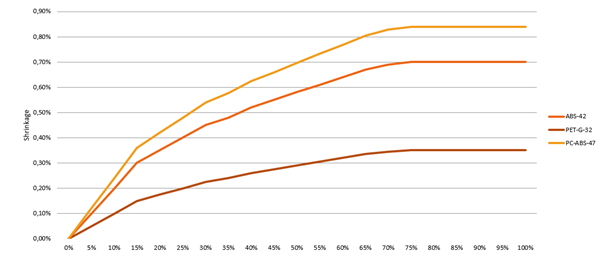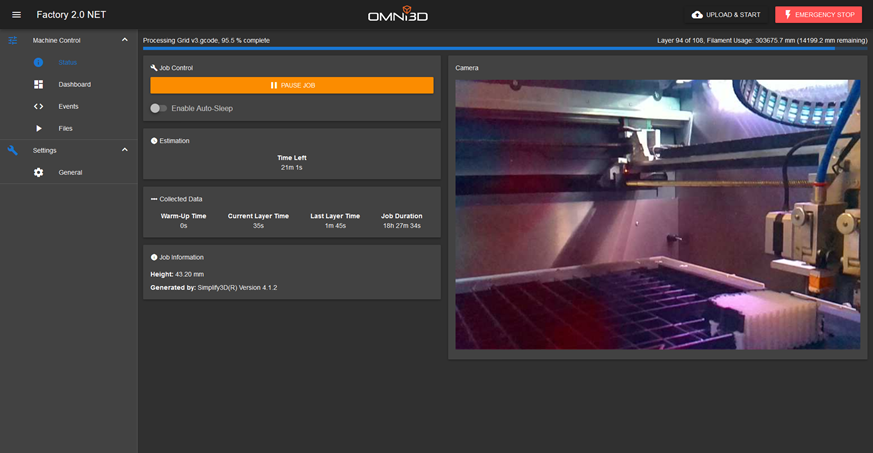Extruder direct cooling system.Omni3D Cooling System™
Extruder direct cooling system.
The Omni3D Cooling System enables the use of the extruder in a heated chamber and provides better control over the dimensional precision of the printout.
The main assumptions of the system are:
- The extruder direct cooling system, which effectively reduces the temperature inside the filament „path” by 40 – 60 ° C. This prevents the filament from reaching the softening point (called Deflaction Point), increasing its stiffness, which affects its control, increases printing speed and process stability over long periods.
- The special construction of the extruder allows to shorten the path between the filament feeding wheel and the nozzle, ensuring more precise feeding of the filament to the softening zone.

The use of this patented technology of direct extruder cooling allowed users of Omni3D printers to print at a higher level of accuracy and gave them the ability to precisely control the amount of filament that is extruded during printing.
Omni3D Filament Flow Control™
Filament flow can be controlled.

Many people think that 3D printing is a really simple matter ... and they are partly right, because just extruding the material and applying it layer by layer is not a demanding process. The stairs begin when we want to print complex geometries and from various materials. In this situation, the head that heats the filament to a certain temperature and applies the material according to the given path is not enough.
This need was a generator of changes in 3D printing, changes that were initiated by industrial 3D printers and industrial filaments for printing. Where did the name „industrial” 3D printers come from?
For at least two reasons. The first is that the broadly understood industry and all kinds of production companies are the recipients of this type of printers. The second reason, on the other hand, is that in industrial printers we use a number of systems that allow us to work on a completely different level. These systems can be compared to systems that are installed in cars, which are also to provide us with safety and the highest quality experience. One such system is the Omni3D Filament Flow Control, as the name says it is a system that allows you to control the flow of filament.
Why is it so important and what is it for? This system ensures precision and dimensional repeatability. Thanks to special encoders, the system counts the amount of filament fed and compares it with the given amount in .gcode. When the discrepancies are too large, the printer informs the operator about it.
Another benefit of this system is the fact that the printer, unlike desktop printers, not only knows if the filament is there or not. Only exactly, she knows how much material she has extruded, and thanks to this knowledge, we are able to plan the time, for example, to replace the bobbin with a new one for large-size printing.
To sum up, an industrial 3D printer is a system of connected vessels that work together for the success of printing a given model, like a team in any team game. One of such systems is Omni3D Filament Flow Control, which watches over the quality, but also over our budget, time and nerves, because it is able to detect the lack of filament, its jams and all undesirable activities that may happen to the filament during printing . All these random events that can happen cause our prints to end up in the trash and we only waste time and money. That is why the systems that are successively implemented by Omni3D are dedicated to companies that focus on quality, reliability and safety.
Omni3D Air Circulation™
Adjusting the temperature of the printout on its entire surface.

In the world of 3D printing, more and more about the power of industrial printers is a closed, actively heated chamber. This factor gives above-average possibilities of monitoring and maintaining an appropriate temperature environment in the printing process.
Many customers are convinced that a heated chamber and an appropriate air circulation system are the key aspects determining purchasing decisions when choosing a 3D printer. It is hard to disagree with this, because many printer manufacturers on the Polish market offer only passive heating of the chamber – using a work table. Therefore, we have developed our own warm air circulation system. Thanks to the use of a 2 kW heater, we are able to assess how our printout will behave both during printing and while cooling down. The very placement of the heater at the bottom of the device is crucial. Hot air coming out through regular cutouts in the heater housing is distributed upwards thanks to the high-efficiency fan, and it does not accumulate only within the working platform.
This creates a kind of cyclone with a controlled temperature in the working space – even up to 70 degrees C. This solution prevents the problem of deformation of the print during printing, because hot air is not directly blown onto the print. In fact, we are able to print large-size elements from demanding materials that shrink during printing, such as ABS. The Omni3D Air Circulation System is perfect for situations where the printouts are expected to last several dozen or even several hundred hours of continuous printing. It becomes especially important when we want precise and repeatable models with a certain degree of filling. To illustrate the above statement, I will use an infographics prepared by our specialists from the Print-Room department.

The diagram above shows the relationship between shrinkage and the degree of filling of the printed element for three types of filaments: ABS-42, PET-G-32 and PC-ABS-47. As you can see, the shrinkage of the ABS printout increases with the increase of the filling level, reaching even 0.7% with 70-100% filling. Therefore, it is possible to predict a specific shrinkage for a given model and potentially enlarge it so that it finally maintains the specified dimensional parameters. Importantly, thanks to maintaining a constant, increased temperature during printing, shrinkage does not occur during the process, but after its completion. As a result, the material shrinks evenly in all directions, reducing geometry deformation and internal stresses. It all boils down to the following conclusions – if we are going to print from engineering materials that require an appropriate and constant temperature inside the printer – it is necessary to have equipment with an actively heated chamber. Then the only limitation becomes our imagination and working space ?.
Omni3D Head Leveling Control™
Automatic extruder height control system.

Omni3D Head Leveling Control is based on the direct measurement of the distance in the Z axis between the right and left extruder.
The automatic extruder leveling system (automatic extruder height control) enables:
- automatic calibration of the distance between the nozzle and the table,
- automatic calibration of the height of nozzles in relation to each other,
- making a mesh map, thus minimizing the impact of table unevenness on the printout.
The extruder automatic leveling system consists in direct measurement of the distance in the Z axis between the right and left extruder. Thanks to this, it allows the head to be used as a probe for the Z-axis leveling sensor. The uniqueness of this system is that the movable heads allow you to take measurements exactly in the place where the filament flows out, i.e. under the nozzle, and not through the sensor, which is away from the tip of the nozzle. Therefore, it gives more accurate information about the position of the head, and this significantly affects the precision of calibration and, consequently, the quality of the printout. In addition, the solution has been programmed in such a way that the calibration of the heads and the table is maintenance-free.
In addition, the automatic extruder height control system minimizes the risk of violating the printout by an inactive head. Lifting the head during printing makes it less likely that the head will catch on the print, and there is no need to consider risk zones when designing and preparing a file. Due to the fact that both heads are movable, the printout never collides with one of the heads and the printing process is not disturbed in any way.
As you can see, the automatic extruder height control system facilitates the operation of the printer, which itself can set the correlation between the heads. At the same time, it gives the user the freedom to create designs without geometric limitations, which would be impossible in the case of two-head printing with a constant head height.
Omni3D Platform Autoleveling System™
Automatic table leveling system.

Platform Autoleveling System is one of the most important systems in modern 3D printers.
Printers working in FDM technology print an object on a so-called work platform, i.e. a flat, horizontal plane or, in other words, a table. Correctly leveling the 3D printer table is one of the first things that must be done before printing, and it is also a necessary step in obtaining a successful printout.
So what is a 3D printer table leveling? This is nothing more than striving for the state in which the 3D printer nozzle will be at the same distance in the Z axis from the build plate, regardless of the position of the print head in the X and Y axes.
Leveling a large surface (platform) is a demanding task, which in Omni3D is developed by studying the flatness trends of the table. Automatic platform leveling, which is included in the Omni3D printers, is performed thanks to the system of 3 Z axis motors. Omni3D printers independently and automatically perform the measurements necessary for proper printing. The head is moved to selected places and measures the distance to the working platform. Measurement is done by testing the height of the platform with the nozzle tip itself, and not with a similar sensor, thanks to which the leveling is more precise and there is no need to carry out additional calibrations of the height difference between the height of the sensor and the nozzle after changing the head.
Manual calibration of the build plate is possible, but it is a time-consuming and tedious process, as it sometimes has to be repeated after a few prints.
The automatic table leveling system significantly facilitates the operation of the 3D printer, as it allows the printer to accurately level the build plate without the need for manual calibration. Thanks to this system, we get high printing precision, the possibility of immediate printing and definitely easier operation for less experienced users.
Omni3D Web Control™
Remote preview of 3D printout by the camera.

Remote management and preview of 3D printer operation are features that significantly change the quality of work with the printer and increase the possibilities of everyday machine management. The connection via the network allows you to easily prepare the printer's temperature and upload files for printing without having to physically approach the machine. Thanks to the integration of the wide-angle camera in the Omni3D printers, users have the opportunity to observe the print progress, but also to introduce temperature changes or interrupt the print in case of unforeseen errors.
Convenient preparation and start of printing on a 3D printer, the ability to monitor and introduce changes in the printing progress and sharing projects with the team – these are just some of the many possibilities offered by working on Omni3D printers equipped with a remote management system.

Omni Web Control enables remote access to the machine from the browser level (both from a laptop, telephone or other network connected device) and is a significant convenience for users who want to control the printout remotely and share the project with a specific group of colleagues. Omni Web Control is not only a remote preview of 3D printing through the camera, but also the ability to perform all procedures without going to the printer.
The Omni3D Web Control system is:
- Integration of the camera in a 3D printer and remote management
- 3D printer fully managed remotely (in the local network)
- Remote access to the 3D printer from a browser (laptop / phone)
- Control using an intuitive interface
- Remote software updates
- Event logging system with the option of downloading them (in the form of a zipped file)
Printers from Omni3D with Omni Web Cotrol are equipped with an event logging system, including a message about the end of printing, thanks to which working with devices becomes much easier and faster. Users of our printers do not have to check the progress of 3D printing directly at the printer, thanks to Omi Web Control it is possible from the browser level.

Moreover, the 3D printer is fully managed remotely in the local network, but it is possible to connect to the machine from Omni3D from external networks via VPN. Thanks to this, remote management of the 3D printer is possible not only from one place on the local network, but from anywhere in the world!
Farm management is an extension of the technology of remote management of a 3D printer. A farm of 3D printers consists of several machines connected to each other in a network that can exchange information about their status or readiness to print.
Technical specification of the Factory 2.0
